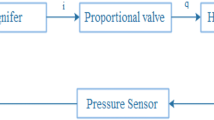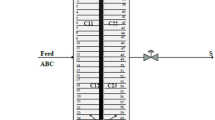Abstract
An optimal design method of operating parameters in hydrogen cyanide (HCN) production process is presented. Firstly the soft sensor model of HCN conversion rate is established by BP neural network. Then considering the practical constraints of operating parameters and taking the maximum HCN conversion rate as objective function, an improved particle swarm optimization (IPSO) algorithm is introduced to optimize the operating parameters, which takes into account the dynamic inertia weight and the particle average position to avoid falling into local optimum and accelerate the convergence. Simulation results with actual production data show that, compared with genetic algorithm (GA) optimization, this method can obtain the optimal operating parameters of the HCN production process.
Access provided by Autonomous University of Puebla. Download conference paper PDF
Similar content being viewed by others
Keywords
- Particle swarm optimization
- BP neural network
- HCN conversion rate
- Operating parameters optimization
- Soft sensing model
1 Introduction
Hydrogen cyanide (HCN) is a colorless transparent toxic liquid with a bitter almond flavor. It is widely used in the electroplating industry, mining industry, cabin and warehouse smoked rodent control, manufacturing all kinds of resin monomers such as methyl acrylate resin and other industries. Furthermore HCN can generate a lot of derivatives, which have important uses in the field of pharmaceuticals, pesticides, fuel, light-sensitive chemicals, and engineering materials. Therefore HCN market demand is broad. Nowadays most of the production of HCN comes from the direct production, while the rest comes from the byproduct of acrylonitrile. But direct method HCN conversion rate is usually low (60–70 %). Therefore, the use of advanced computational intelligence techniques to study imminent HCN conversion rate increases. However, the current research literature in this respect at home and abroad is rare. Neural network can establish the object mathematical model without considering the exact process by its strong nonlinear approximation ability, it is widely used in the modeling of complex chemical processes [1–3]. Particle swarm optimization (PSO), which comes from simulating birds foraging in the process of migration and clustering behavior, is a global random search algorithm based on swarm intelligence. PSO can be used to solve a large number of nonlinear, nondifferentiable and multi-peak complex optimization problems [4, 5]. In this paper, BP neural network is used for establishing the soft sensor model of HCN conversion rate firstly, then taking the maximum HCN conversion rate as objective function, an improved PSO algorithm is presented to optimize the operating parameters. The research results can provide a new way of thinking to improve HCN conversion rate in actual production process.
2 HCN Conversion Rate Soft Sensing Model Based on BP Network
The direct method is also called Andrussow method by using methane, ammonia gas and oxygen as the main raw material. It is an ammonia oxidation with the raw material mixture passing through the wire mesh-like catalyst bed made of platinum iridium alloy in the conditions of atmospheric pressure and 1000 °C above. Literature [6] indicates that three-layer BP neural network can be realized arbitrarily complex nonlinear mapping as long as enough hidden nodes. That is to say it can approximate function with arbitrary precision to achieve a very curve fitting. Therefore we use three-layer BP neural network to establish HCN production process firstly. Comprehensively analyzing of the HCN production process, the nine operating parameters of HCN (the settings of the control system, shown in Table 50.1) is chosen as the input variables of BP neural network and the output is HCN conversion rate. The nodes of hidden containing layer are 5, the transfer function of hidden layer nodes is Tausig function and the transfer function of output layer nodes is Logsig function.
The BP neural network training samples come from 3411 groups of HCN real-time production data in Chongqing Unisplendour Chemical Plant, in which 3241 groups are selected randomly as network training and the rest of 170 groups are selected as predictive test. Firstly HCN production data are preprocessed, including gross error elimination, \( 3\sigma \) method and five-spot triple smoothing algorithm. The preprocessed data are shown as Table 50.2, where \( \alpha \) denotes HCN conversion rate.
Figure 50.1 shows the predicted HCN conversion rate by trained BP neural network and Fig. 50.2 shows the error between prediction output and desired output. The prediction performance indicators are as follows: mean absolute deviation (MAD) is 1.1248, mean square error (MSE) is 2.4826, mean forecast error (MFE) is 0.0327 and mean absolute percentage error (MAPE) is 1.5938.
3 IPSO Algorithm
Particle swarm optimization (PSO) algorithm is a new evolution of computing technology based on social group behavior. The basic idea of PSO algorithm is derived from study on the behavior of birds prey. In PSO, each iteration of the particle updates itself by tracking personal optimal position and group optimal position until now. Therefore, this algorithm is an efficient parallel search algorithm, which can be used to solve a large number of nonlinear, nondifferentiable, and multi-peak complex optimization problems. The basic PSO algorithm can be described as follows:
Assume m particles compose a group in D-dimensional target search space, where the ith particle is expressed as a D-dimensional vector \( x_{i} = (x_{i1} ,x_{i2} , \cdots x_{iD} ), \) that is the potential solution. The best previous position of any particle is recorded and represented as pbest. The best particle among all particles is called as gbest. The flight velocity denoted by \( v_{i} = (v_{i1} ,v_{i2} , \cdots v_{iD} ) \) is also a D-dimensional vector. The position and velocity of particles are updated according to the following equations.
where \( i = 1,2, \cdots ,m,d = 1,2, \cdots ,D \), ω is inertia weight which decides the impact of particle present speed to next generation. \( c_{1} \) and \( c_{2} \) are acceleration coefficients with positive values. The relative sizes of \( c_{1} \) and \( c_{2} \) reflect the relative importance of \( p_{i} \) and \( p_{g} \) in evolution. \( r_{1} \) and \( r_{2} \) are random numbers between 0 and 1. \( v_{id} \in \left[ { - v_{d}^{\hbox{min} } ,v_{d}^{\hbox{max} } } \right] \), \( x_{id} \in \left[ { - x_{d}^{\hbox{min} } ,x_{d}^{\hbox{max} } } \right] \), \( v_{{_{d} }}^{\hbox{min} } \), \( v_{{_{d} }}^{\hbox{max} } \), \( x_{d}^{\hbox{min} } \) and \( x_{d}^{\hbox{max} } \) represent actual bounds.
Suitable selection of inertia weight provides a balance between global and local explorations, thus requiring less iteration on average to find a sufficiently optimal solution. As originally developed, often decreases linearly from 0.9 to 0.4 during a run. The inertia weight is set according to the following equation [7].
where \( \omega_{start} \) is initial inertia weight, \( \omega_{end} \) is inertia weight iterated to maximum number, \( k \) is the number of iterations, \( G_{\hbox{max} } \) is the maximum number of iterations.
As we known, each particle only uses individual optimum and group optimum information in basic PSO algorithm. Considering the sharing of information in group is the result of an evolutionary, the idea of group average position is presented to avoid group into a local optimum and accelerate the convergence.
Supposing that a particle swarm is composed of m particles, then the positions of m particles can be denoted as \( \left[ {P_{1} \;\;P_{2} \; \cdots P_{m} } \right] \), and the average position of \( m \) particles is
Therefore the velocity update equation of IPSO algorithm is
where \( c_{3} \) is a positive constant, \( r_{3} \) is a uniform random number between 0 and 1, \( \omega \) is shown as Eq. (50.3). The position update equation of IPSO algorithm is equal to basic PSO algorithm as Eq. (50.2).
It can be seen from Eq. (50.5) that each particle in IPSO draws lessons form the experience of other particles and uses more information to decide its own behavior. In other words, each particle is on longer search between group optimum and individual optimum, but in group optimum, group average position and individual optimum. IPSO algorithm still retains particle swarm global best position, and furthermore, it can speed up the convergence rate, while group average position is used for avoiding the group into a local optimum.
4 Operating Parameters Optimization of HCN Conversion Rate
Choosing the maximum HCN conversion rate as fitness function, GA and IPSO are used for optimizing the operating parameters respectively and the results are shown in Table 50.2; Figs. 50.3 and 50.4. In IPSO, evolutionary generations are 200, population numbers are 80, acceleration coefficients \( c_{1} = c_{2} = 1.5 \), \( c_{3} = 1.2 \), inertia weight \( \omega = 0.9 - 0.5*k/70 \). In GA, crossover probability is 0.4, mutation probability is 0.2, evolutionary generations and population numbers are the same as IPSO. The actual constraint ranges of operating parameters are also shown in Table 50.3.
The simulation results show that the optimization performance of IPSO is better than GA. IPSO has a faster convergence rate and stronger extremum optimization ability. In Figs. 50.3 and 50.4, GA evolves to 188 generation to converge to 79.1282, while IPSO only evolves to 141 generation to converge to 82.4150. The optimized operating parameters are shown in Table 50.2.
5 Conclusion
According to the fact that direct method HCN conversion rate is low in Chongqing Unisplendour Chemical Plant, in this paper, firstly the soft sending model of HCN conversion rate is established by BP neural network, and then the operating parameters of HCN production process are optimized by GA and IPSO respectively to achieve extremum optimization. IPSO takes into account the dynamic inertia weight and the particle average position to avoid falling into local optimum and accelerate the convergence. The simulation results show that the optimization performance of IPSO is better than GA. Furthermore, the optimized operating parameters have been used in practical production to improve HCN conversion rate indeed, therefore this paper has a certain academic value and engineering significance.
References
Wu M, Xu CH, She JH, Cao WH (2012) Neural-network-based integrated model for predicting burn-through point in lead-zinc sintering process. J Process Control 22(5):925–934
Shakil M, Elshafei M, Habib MA, Maleki FA (2009) Soft sensor for NOx and O2 using dynamic neural networks. Comput Electr Eng 35(4):578–586
Tian XM, Wang Q, Deng XG (2011) Soft sensing based on wavelet neural networks with momentum. J Chem Ind Eng 62(8):2238–2242 (in Chinese)
Gao S, Zhang ZY, Cao CG (2010) Multiplicate particle swarm optimization algorithm. J Comput 5(1):150–157
Yang TQ (2011) A multi-objective PSO algorithm for energy-efficient scheduling. Adv Mater Res 143–144:663–667
Hassoun MH (1995) Fundamentals of artificial neural networks. The MIT Press, Cambridge
Kennedy J, Eberhart R (1995) Particle swarm optimization. In: Proceedings of the IEEE international conference on neural networks. Perth, pp 1942–1948
Acknowledgments
The authors would like to appreciate the support of Chongqing Educational Committee Science and Technology Research Project (KJ121407) and Chongqing University of Science and Technology Intramural Scientific Foundation (CK2011B11).
Author information
Authors and Affiliations
Corresponding author
Editor information
Editors and Affiliations
Rights and permissions
Copyright information
© 2013 Springer-Verlag Berlin Heidelberg
About this paper
Cite this paper
Zhang, Y., Li, T. (2013). Optimization Design of Operating Parameters for Hydrogen Cyanide Conversion Rate Based on an Improved Particle Swarm Optimization and BP Neural Network. In: Lu, W., Cai, G., Liu, W., Xing, W. (eds) Proceedings of the 2012 International Conference on Information Technology and Software Engineering. Lecture Notes in Electrical Engineering, vol 211. Springer, Berlin, Heidelberg. https://doi.org/10.1007/978-3-642-34522-7_50
Download citation
DOI: https://doi.org/10.1007/978-3-642-34522-7_50
Published:
Publisher Name: Springer, Berlin, Heidelberg
Print ISBN: 978-3-642-34521-0
Online ISBN: 978-3-642-34522-7
eBook Packages: EngineeringEngineering (R0)








